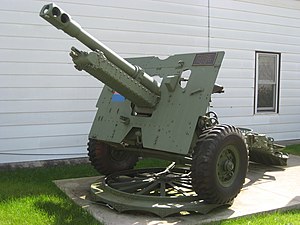QF 25 pounder
| Ordnance QF 25-pounder | |
|---|---|

Ordnance QF 25-pounder gun shown mounted on its firing platform, King Street West, Dundas, Hamilton, Canada.
|
|
| Type | Field gun/Howitzer |
| Place of origin | United Kingdom |
| Service history | |
| In service | 1940–present |
| Used by | See users |
| Wars |
World War II Malayan Emergency Korean war Rhodesian Bush War South African Border War Dhofar Rebellion Turkish invasion of Cyprus Lebanese Civil War Sri Lankan Civil War Iraqi insurgency |
| Production history | |
| Designed | 1930s |
| Manufacturer | Royal Ordnance |
| Variants | See variants |
| Specifications (Mk II on Carriage Mk I) | |
| Weight | 1,633 kg (3,600 lb) |
| Length | 4.6 m (15 ft 1 in) muzzle to towing eye |
| Barrel length | 2.47 m (8 ft 1 in) (28 cal) |
| Width | 2.13 m (7 ft) at wheel hubs |
| Height | 1.16 m (3 ft 10 in) trunnion height |
| Crew | 6 |
|
|
|
| Shell | High explosive Anti-tank Smoke |
| Shell weight | 11.5 kg (25 lb) (HE including fuze) |
| Calibre | 87.6 mm (3.45 in) |
| Breech | Vertical sliding block |
| Recoil | Hydro-pneumatic |
| Elevation | -5° to 45° (80° with dial sight adapter and digging trail pit or wheel mounds) |
| Traverse | 4° Left & Right (top traverse) 360° (platform) |
| Rate of fire | Gunfire, 6–8 rpm Intense, 5 rpm Rapid, 4 rpm Normal, 3 rpm Slow, 2 rpm Very slow, 1 rpm |
| Muzzle velocity | 198 to 532 m/s (650 to 1,750 ft/s) |
| Maximum firing range | 12,253 m (13,400 yd) (HE shell) |
| Sights | Calibrating & reciprocating |
The Ordnance QF 25-pounder, or more simply 25-pounder or 25-pdr, was the major British field gun and howitzer during World War II. It was introduced into service just before the war started, combining high-angle and direct-fire, relatively high rates of fire, and a reasonably lethal shell in a highly mobile piece. It remained the British Army's primary artillery field piece well into the 1960s, with smaller numbers serving in training units until the 1980s. Many Commonwealth of Nations countries used theirs in active or reserve service until about the 1970s and ammunition for the weapon is currently being produced by Pakistan Ordnance Factories.
The design was the result of extended studies looking to replace the 18-pounder (3.3 inches (84 mm) bore) field gun and the 4.5-inch howitzer (114.3 mm bore), which had been the main field artillery equipments during the First World War. The basic idea was to build one weapon with the high velocity of the 18-pounder and the variable propelling charges of the howitzer, firing a shell about halfway between the two in size, around 3.5–4.0 inches (89–102 mm) of about 30 pounds (14 kg).
Development during the inter-war period was severely hampered by a lack of money and it was eventually decided to build a "new" design from existing 18-pounders by converting barrels but designing a new barrel and carriage for production when funds were available. The result was a 3.45 inches (87.6 mm) weapon firing a shell weighing 25 pounds (11.3 kg). It was mounted on late model 18-pounder carriages. One of these used a circular firing platform and this was adopted for the new guns. The firing platform was attached to the gun and when lowered the gun was pulled onto it. This platform transferred most of the recoil forces to the ground, instead of using the spade at the end of the trail, making the gun very stable when firing. It also provided a flat smooth surface for the carriage to rotate on using the road wheels, this enabled the gunners to traverse the carriage quickly in any direction.
Unlike the 18-pounder, the 25-pounder used howitzer-type variable-charge ammunition. The 25-pounder was separate-loading; the shell was loaded and rammed, then the cartridge in its brass case was loaded and the breech closed. In British terminology the 25-pounder was called "quick firing" (QF), originally because the cartridge case provided rapid loading compared with bag charges, and was automatically released when the breech was opened.
...
Wikipedia
